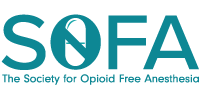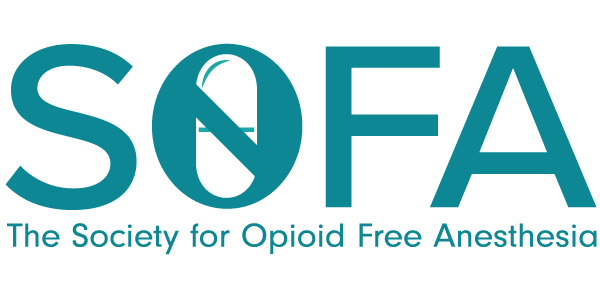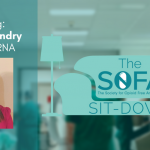SOFA Sit-Down Featuring John Craig Vana, MSN, CRNA
1. Tell me about your current practice and how it involves opioid-free anesthesia.
I graduated from the University of Iowa in 2008 and have been in CRNA-only Critical Access Hospital Practices for the last 11yrs. I just joined Columbia Anesthesia in Columbus, WI at the beginning of this year. Prior to that I was at Grundy County Memorial Hospital (GCMH) in Grundy Center, IA as the sole anesthesia provider for this critical access hospital for about 7 years.
I’m excited about being able to bring OFA experience to the table for both clinical practice in Columbus and clinical teaching opportunities with the SRNAs of Rosalind Franklin University
Being the only anesthesia provider at my prior facility, GCMH, both assisted and hindered the integration of OFA into my daily practice. Laying the groundwork and education of staff was actually the easy part of the transition to OFA. Early on in the process, I did provide the perioperative RN staff with some education regarding the techniques and pharmacology used with OFA. Shortly after transitioning towards OFA, the hospital also joined an Opioid Guardianship Project that was organized by the Iowa Department of Public Health, and that facilitated working with the hospitalist and surgeons to integrate some of the OFA pharmacology into the postop phase as well for our post op inpatients.
The largest barrier for me in starting into OFA was trying to piece together the knowledge base of the physiology and pharmacology on my own, without any other CRNA brains readily available to bounce ideas off of. This was actually the genesis of the OFA guide that I put together, and that is being released with this SOFA Sit Down.
I created the OFA guide to help myself better understand and wrap my head around when and how to combine the pharmacology. After roughing out the guide, I reached out to Tom Baribault to help me refine the reference. He was generous enough to recruit some other stellar CRNAs like Brian Selai, Jason McLott, Eric Kramer, Jason White, Alison Karmanian, James Stockman and Matthew Earl to help polish off the rough edges. After that, it was only logical to share the OFA Guide with the rest of the SOFA membership to help others in understanding how it all works together and make it less intimidating to try new techniques.
2. What drove you to explore opioid-free anesthesia practices?
In short, professional curiosity.
I worked as a Paramedic during nursing school, and when I was doing the clinicals for that certification, I received some of the best advice I’ve ever gotten. That advice was to “expose yourself to as many different providers and see as many different ways of doing things as you can. You will quickly be able to discern which parts of other peoples practice that don’t work well, and what pieces of each provider’s practice you will want to make your own. In the end, you become a product of all the best techniques and practices of all your predecessors.”
As a result, I’ve always been open-minded to the idea that the way I practice isn’t the only way to practice, or necessarily even the best. When I first heard about OFA, it was hard for me to believe it was even possible to provide good anesthesia care without using opioids.
In the end, my transition to OFA is the product of the disbelief that it is actually possible and my curiosity of always looking for a better way to practice that led me down the OFA path.
3. Share with us your first experience practicing opioid-free anesthesia
There are two cases from this past year that really standout, and made me think that OFA is the way to go.
The first case was a middle-aged woman who was in for a Laparoscopic Cholecystectomy. She had a few chronic and well controlled co-existing diseases, but was otherwise healthy. I did not do any TAP blocks as I didn’t have a suitable ultrasound machine at the time. I provided her with the normal PO meds upon her arrival, Tylenol, Celebrex and Gabapentin, as well as some IV Pepcid and Zofran. Did a fairly standard induction with Versed, Ketamine, Propofol, IV Lidocaine, Rocuronium and an LTA kit. I worked in small boluses of Precedex after induction, bolused with Decadron and 1 Gm of Magnesium, and put the remainder of the Magnesium dose in the IV fluids. Maintained her anesthesia on Nitrous and Des and the surgeon localized the port sites. At the end of the case about 45 minutes later, I reversed the paralytic, and she was immediately back breathing at about 28/min. I remember getting really nervous that she would be hurting upon wake up with that respiratory rate. Luckily, one of the recurring pieces of advice I was given by other CRNAs who are practicing OFA was that patients would be relatively tachypnic compared to prior experience. I decided to not give any opiates and see how she did after being extubated. Shortly after starting emergence, the patient was extubated, to recovery alert and oriented, pain free, and was discharged home with a pain of “ZERO” 80 minutes after extubation.
The second case was a Total Hip on the mother of one of the hospital RNs. She had previously been admitted for 3-4 days post op on several occasions with intractable PONV following prior surgeries. This patient could hardly walk preop, and had postponed surgery for way too long because she was so scared of the PONV that would likely follow the THA. She had an average daily pain sore of 7 of 10 in the weeks leading up to her surgery. After explaining what I wanted to do for her and why, she decided she was on board. She even told the surgeon in preop she wasn’t going to need any postop opioids. He was skeptical, and wrote her a prescription anyway “just in case she needed it”. For her anesthetic I did a preop Fascia Iliacia block with 50ccs of 0.2% Ropivacaine and Decadron 10mg. She also got the normal preop PO meds of Tylenol, Celebrex and Gabapentin. Provided an opioid free spinal and sedation for the surgery including Versed, Ketamine, Precedex and Propofol, and used a bolus and drip of Magnesium as well. She was discharged after walking several laps of the nursing unit POD1 and recovering overnight from the short motor weakness with the Fascia Iliaca block. She continued on Tylenol and ibuprofen post op. I saw this patient in the community about 2 months post op, and she confirmed she never took a single opiate even during her entire recovery and physical therapy. She recalled that her maximal pain score was 1-2 of 10 during the entire recovery. Most important to her, this was the first surgery she had no PONV with.
4. How long have you been practicing OFA?
It’s been a process to integrate the knowledge and techniques over the better part of this past year, and I continue to refine what I do with more and more experience. I only really started implementing OFA clinically in May and June of 2018. I’ve been intentional about my transition to OFA, but once I got started it has been about 5 months to really start to feel comfortable with the practice.
I would encourage anyone starting this journey to not expect overnight success, and allow yourself time to understand the physiology and pharmacology before dipping your toe in the water. I took 6 months just to network, read and educate myself on OFA before starting to add it slowly into my practice.
5. How often do you utilize OFA practices?
Daily and as often as possible. I haven’t come across a case or a patient yet that doesn’t benefit from at least some multimodal pharmacology with the intent of opioid sparing.
6. Explain how you have measured your progress with OFA
At my prior practice we used EPIC for Pre and Post op only, and Intraop documentation is on paper. As a result, it was hard to extract data from patient records to measure progress. As a surrogate for opiate administration, I recruited the pharmacist to run dispensing reports from Pyxis on the controlled substances for 2-month periods during a “control, implementation, and post implementation” phase. Since I was the only anesthesia provider at that facility, it was quite a bit easier to measure the progress this way towards OFA.
As a result of analyzing this data, we were able to determine that during the control phase, that 86% of patients were getting an opioid during their perioperative period. I had already been doing OFA in endoscopy for many years, and this accounted for the 14% of patients not getting any opioids during this period. We were able to reduce the opiate dispensing for the entire perioperative phase by 35% during the implementation phase.
Conceptualizing this as an evolution of practice instead of expecting overnight success allowed myself some time and grace to refine the techniques of OFA. After I got a better handle on the nuances and pharmacology, there was a further reduction in opioid dispenses from the implementation phase to the post implementation phase.
From beginning to end, we were able to reduce total perioperative opioid administration by 74.9% over a period of 10 months. Or, to look at it another way, in a period of 8 weeks of full time practice during the post implementation phase with 97 cases, I gave 100mcg of Fentanyl or less to 5 patients. All the rest of the 92 cases I did, including total joints and intra-abdominal cases, have been OFA.
7. What are some of the changes you have observed in your practice after implementing OFA?
The biggest thing that I’ve noticed, and have been completely surprised by, is that after looking at the controlled substance dispensing data from Pyxis, PACU opioid administration has actually gone down with giving less opioids intraop. This has been observed by other OFA CRNAs as well, and makes me think that the opioid induced hyperalgesia phenomenon is exponentially underappreciated. Also, PONV has all but disappeared, even in those patients with a history of severe PONV.
Personally and professionally, I am much more purposeful in planning the anesthetic. For the more invasive cases with more physiologic trespass, I’m making sure that I am covering and modulating all the receptors and inflammatory substrates that I can in addition to as much regional anesthesia as I can apply to the different cases.
8. What feedback have you received about OFA from patients, surgeons, & staff?
The most surprised patients are those that have had problems previously with PONV. I’ve had several patients now that have previously been admitted for PONV control following prior surgery, and have done fantastically well following an OFA anesthetic.
Surgeons have commented that the quality of the patient’s recovery 1-2 weeks out at their post op visits have improved. Unfortunately, none of the surgeons have come to their own conclusion or realization that the only significant change in the past several months has been the transition to OFA. I guess for some reason, I’m more concerned that the surgeons would be in disbelief and try to chalk it up to something else rather than pointing out the only real change has been towards OFA. I’ll probably turn blue, but I’m still holding my breath that one of them realizes this point.
Finally, the OR staff was quite skeptical at first. The in-service that I did certainly helped them better understand why we were going to move in the OFA direction. Now that we have been doing OFA a while, and seeing how patients are doing post op, the recovery RNs are happy to get the OFA patients because they have seen that they are comfortable, not puking and fairly quickly ready for discharge.
9. Describe any obstacles/setbacks you had to overcome in implementing OFA. How did you overcome them?
All of the surgeons I worked with at GCMH are in private practice and have many years of practice under their belts. As a result, even with total joints, we rarely have a case that lasted much more than 45 minutes to an hour. When I first started transitioning to OFA, I now realize I was overshooting on the Precedex and ketamine for our shorter cases out of a fear that patients would be hurting in recovery. It took some analyzing and fine-tuning, but eventually other CRNAs like Tom helped me realize that I could actually get desirable analgesia with less medications. For the shorter cases like I used to have, the maintenance infusions are un-necessary, and most of the time I like to keep the Precedex boluses to less than 0.3mcg/kg ideal or adjusted body weight, and Ketamine to less than 0.3mg/kg ideal or adjusted body weight.
I still had some surgeons that are resistant from time to time, like you do at any facility, to doing things differently. Their resistance isn’t so much a desire to not participate in OFA, but is more that they are worried about delays in their schedules with anything new. The rest of the perioperative staff have seen the benefits of the transition to OFA, and have been helpful in tweaking the OR schedule to facilitate the block placements without delaying the surgeons. Sometimes that means staff are coming in to work a bit earlier than normal, or shuffling up the schedule to facilitate blocks while the surgeons are occupied in clinic. But, after putting it all together, I’m lucky that the OR staff has been so cooperative and willing to try something new together.
10. How has OFA helped you in transitioning your practice to incorporate more OFA techniques?
Being the only CRNA at GCMH left me living on a virtual island. When I first joined SOFA at the end of 2017, I devoured everything on the membership side of the website. The publications, discussion forums, power points and other CRNA SOFA members have all been a wealth of information in helping me understand and implement OFA. My hope is that the OFA guide that I put together, to help myself better understand everything, will help others feel less intimidated by the transition.
11. What advice can you provide to other anesthesia providers who are looking into OFA but have not taken the first step to include it in their practice?
Several things come to mind.
First, decide if this is for you. I’d recommend taking a look at two recent articles and see if this is something that you want to dedicate the time to learning.


Second, my biggest concern before starting was understanding the cellular level mechanisms of action and identifying where the dangers and minefields were in the pharmacology. Jason McLott’s “Abandoning the Mu Receptor” power point on the SOFA website does a great job of explaining the cellular physiology. As for the pharmacology, the journal publications on the SOFA site and the existing SOFA Guide to Non-Opioid Analgesics provides a very useful summary of the contraindications and pearls of wisdom for each of the adjuvant medications. Finally, the soon to be released SOFA Medication Clinical Reference Tool will be a fantastic resource to anyone starting into OFA.
Next, talk with those who are using these techniques if at all possible. There is so much wisdom in those CRNAs that practice OFA on a regular basis. Much of this knowledge is not in the literature yet, and there are many nuances that can’t possibly be communicated in the literature even if they were all documented with studies.
Finally, have confidence. We are all professionals, and as a result, know that if something doesn’t seem to be working the way you think it should, don’t despair and give up. As you are making the transition, there are going to be some patients that will likely need some opioids in PACU. This isn’t a failure, its just part of the professional development. The transformation to OFA is a process, and I’d be surprised if anyone could undertake the transformation in less than 6-9 months.
12. What do you think needs to happen to advance OFA in the next five years?
Before we touch on what needs to happen, it is worth mentioning what is already happening.
We have all just survived the transition to ICD10. The powers that be are already working on ICD11, and it has been reported that a major focus will be to reclassify chronic post-operative pain and chronic post-operative opioid use to a complication of surgery. Knowing that treatment of other postoperative complications are already included into the bundled payment, it is safe to assume that these complications will be as well under the new system, and the cost of treatment will fall on providers and facilities.
Therefore, it is important for CRNAs to be at the forefront of the OFA movement now, and to be ready as an available solution to this reclassification with knowing and practicing OFA when these changes go into effect.
I would love to see further CRNA led research focus on a few areas. A coordinated effort with dozens of simultaneous DNP projects across the country investigating specific aspects of OFA would be very beneficial to position CRNAs as the leaders in what I believe will be a seismic shift in anesthesia going forward. A few of those directions for investigation come to mind.
First, I personally believe that opioid induced hyperalgesia is an exponentially underestimated and under appreciated phenomenon. Seeing first hand that giving less intraoperative opioids produces less PACU opioid administration supports this theory. After talking with other OFA CRNAs, they too have been able to quantify this phenomenon in their practices. Re-examining the hyperalgesic effect of opioids would be valuable to determine just how detrimental opioids actually are to patients overall well-being and recovery from surgery.
Second, OFA isn’t just the lack of giving opioids. It is replacing the opioids with analgesics that have secondary benefits. This results in an anesthetic that conveys not just analgesia, but also anti-hyperalgesic, anti-inflammatory and adrenergic attenuating properties that translate into long term benefits and improved recovery. A better understanding of the hormonal, endocrine and immune effects and how these responses are affected by the multimodal pharmacology of OFA should be a top priority.
Lastly, education and exposure to OFA. By exposing SRNAs to this now, and facilitating and incorporating OFA into a new generation of CRNA practice, it is possible that 30 years from now OFA will no longer be a fringe movement by a few early adopters. Rather, I forsee OFA morphing into and becoming mainstream. Over time, I believe that OFA will eventually just be how anesthesia is provided in the next few decades.
If there’s someone you’d like to see featured on the “SOFA Sit-Down,” send an email to info@goopioidfree.com!





